Why in news?
- After 1 year of pilot phase, based on IPC’s involvement, contribution and future potential, the decision on inclusion as permanent member of PDG was taken.
About Indian Pharmacopoeia Commission:
- It is an autonomous Institution of the Ministry of Health and Family Welfare, Govt. of India.
- It is created to set standards of drugs in the country.
- Functions:
- Its basic function is to update regularly the standards of drugs commonly required for treatment of diseases prevailing in this region.
- It publishes official documents for improving Quality of Medicines by way of adding new and updating existing monographs in the form of Indian Pharmacopoeia (IP).
- It further promotes rational use of generic medicines by publishing National Formulary of India.
- It prescribes standards for identity, purity and strength of drugs essentially required from health care perspective of human beings and animals.
- It also provides IP Reference Substances (IPRS) which act as a finger print for identification of an article under test and its purity as prescribed in IP.
What is Indian Pharmacopoeia (IP)?
- These standards are authoritative in nature. They are enforced by the Regulatory authorities for quality control of medicines in India.
- During Quality Assurance and at the time of dispute in the court of law the IP standards are legally acceptable.
- It is an official document meant for overall Quality Control and Assurance of Pharmaceutical products marketed in India by way of contributing on their safety, efficacy and affordability.
- It contains a collection of authoritative procedures of analysis and specifications for Drugs.
- The IP, or any part of it, has got legal status under the Second Schedule of the Drugs & Cosmetics Act, 1940 and Rules 1945 there under.
Key facts about the Pharmacopeial Discussion Group
- It was formed in 1989 with representatives from the European Directorate for the Quality of Medicines in the Council of Europe (the European Pharmacopoeia), the Ministry of Health and Welfare—now the Ministry of Health, Labor, and Welfare (MHLW) the Japanese Pharmacopoeia, and the United States Pharmacopeial Convention, Inc., (the U.S. Pharmacopeia).
- In May 2001, PDG welcomed the World Health Organization as an observer.
- It generally meets twice a year and holds monthly status and technical teleconferences to advance harmonization work.
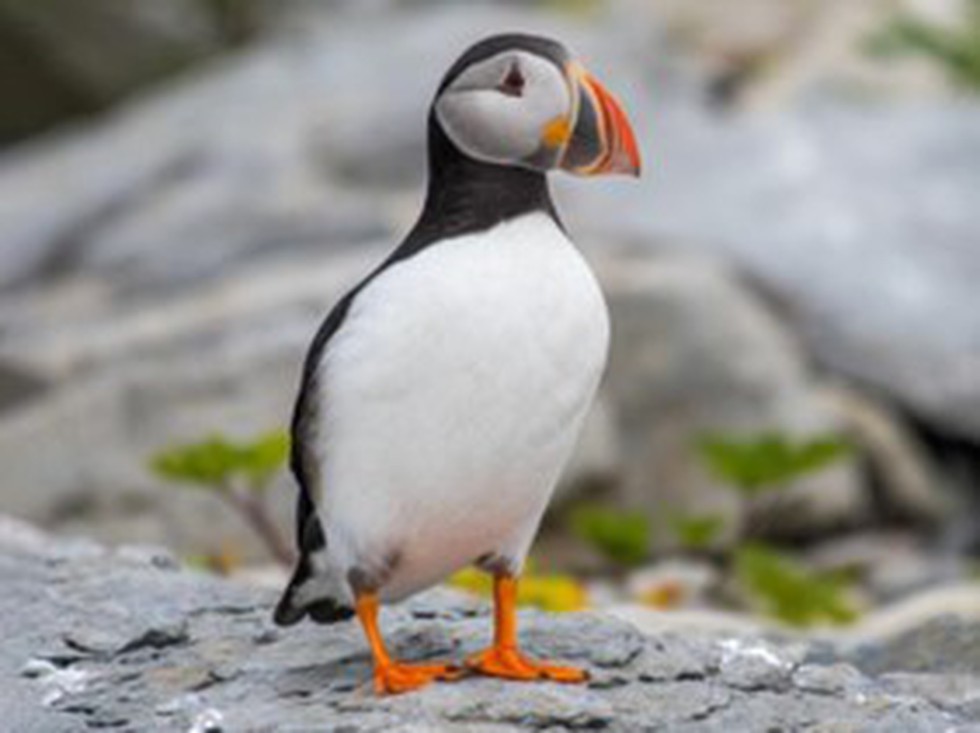
About Atlantic Puffin:
- It is a species of small seabird in the auk family.
- It's the only puffin species found in the Atlantic Ocean.
- Scientific Name: Fratercula arctica
- Habitat: It is found on rocky coasts in the Northern Atlantic Ocean during the breeding season and on the open ocean in the non-breeding season.
- Geographical Range:
- It is a migratory species, spending most of the time traveling back and forth across the Atlantic Ocean, returning every breeding season to its native breeding areas.
- Sixty percent of the individuals inhabit the coast of Iceland during the breeding season.
- It has also been found off the coast of Greenland, the United Kingdom, Eastern Canada, and the Netherlands, as well as Ireland.
- Features:
- It is a short and stocky diving seabird about 12 inches in length with a wingspan of 20-24 inches.
- It is black on its upper sides and white on its chest and belly.
- Males and females look alike.
- It has bright orange webbed feet; a white face and cheeks; and a large, triangular parrot-like bill that is bright red and yellow.
- They fly through the air like most birds, but they also "fly" through the water, using their wings as paddles.
- They are also speedy in the air. They flap their wings up to 400 times a minute, speeding along in the air at 55 miles an hour.
- Diet: Puffins eat small fish—such as sand eels and herring—which they hunt underwater.
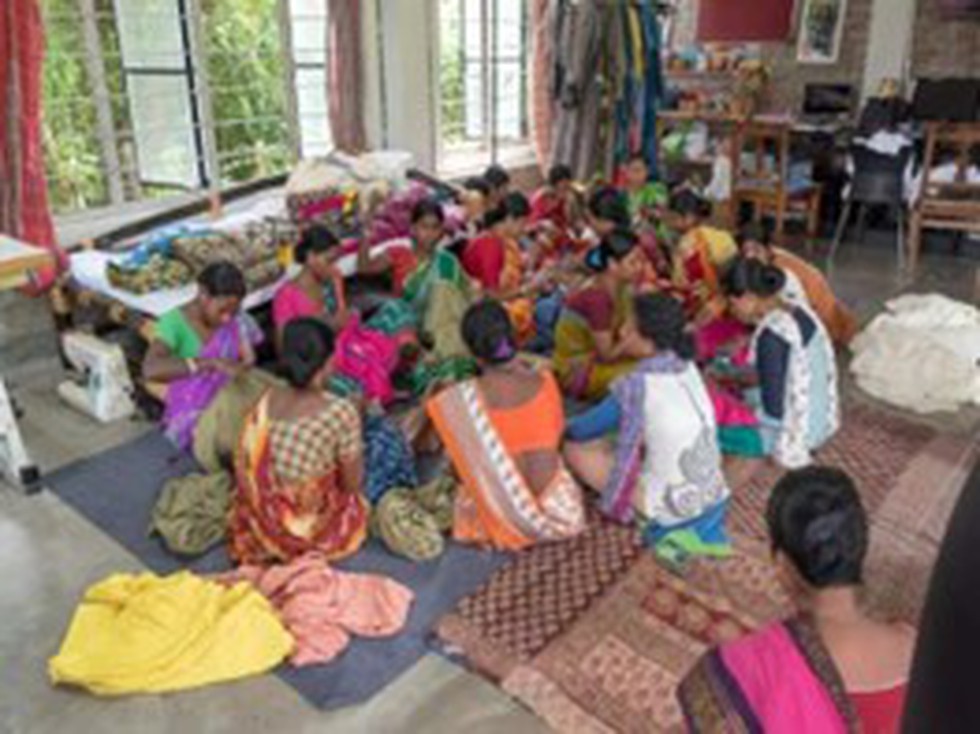
About Lakhpati Didi Initiative:
- It was announced by the Prime Minister in his Independence Day speech on August 15, 2023.
- Objective: To encourage women to start micro-enterprises within their villages.
- Under the Lakhpati Didi Initiative, the government aims to train two crore women.
- The programme is aimed at training women in self-help groups (SHGs) so that they can earn a sustainable income of at least Rs 1 lakh per annum per household.
- The initiative has been initiated by DAY-NRLM, wherein each SHG household is encouraged to take up multiple livelihood activities coupled with value chain interventions, resulting in a sustainable income of Rs 1 lakh or more per year.
- Under this scheme, women will be trained in various skills, such as plumbing, LED bulb making, drone operation and repair, and tailoring and weaving.
- After completing the training, women will be provided with opportunities to earn income using their skills.
- The ministry of rural development is adopting a whole-of-government approach for maximum impact through convergence to transform the rural economy with the enabling of ‘Lakhpati Didis’.
What is Deendayal Antyodaya Yojana-National Rural Livelihoods Mission (DAY-NRLM)?
- It is a flagship poverty alleviation program implemented by the Ministry of Rural Development, Government of India.
- Aim: To reduce poverty by enabling the poor household to access gainful self-employment and skilled-wage employment opportunities, resulting in sustainable and diversified livelihood options for the poor.
- DAY-NRLM adopts a demand-driven approach, enabling the States to formulate their own State-specific poverty reduction action plans.
- The Mission seeks to achieve its objective by investing in four core components.
- social mobilization, promotion, and strengthening of self-managed and financially sustainable community institutions of the rural poor women;
- financial inclusion;
- sustainable livelihoods;
- social inclusion, social development and access to entitlements through convergence;
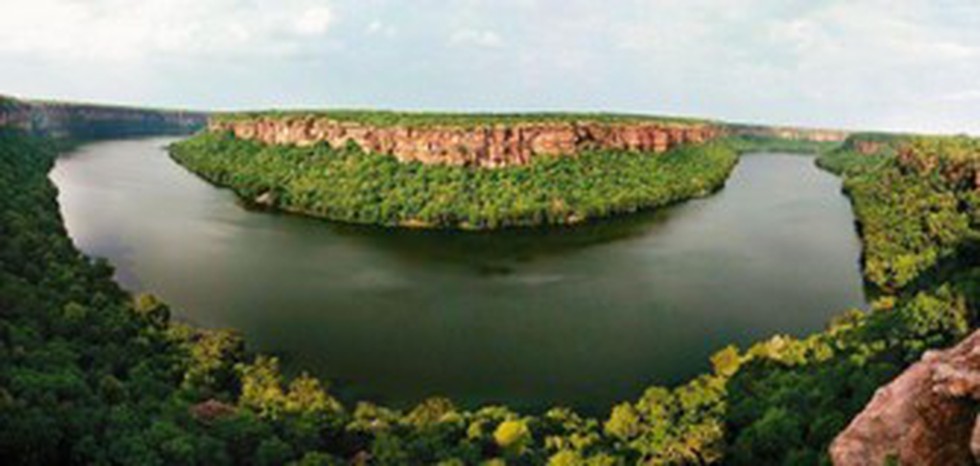
About Mukundra Hills Tiger Reserve:
- Location: Mukundra Hills Tiger Reserve, popularly known as Darrah Wildlife Sanctuary, is spread across 4 districts– Bundi, Kota, Jhalawar, and Chittorgarh in Rajasthan.
- The park is situated in a valley formed by two parallel mountains, Mukundra and Gargola.
- The tiger reserve was constituted in the year 2013,s which encompasses the area of Mukandra National Park, Dara Sanctuary, Jawahar Sagar Sanctuary, and part of Chambal Sanctuary.
- It was once a hunting preserve belonging to the Maharaja of Kota.
- River: It is located on the eastern bank of the Chambal River and is drained by its tributaries.
- Vegetation: Dry Deciduous Forest
- Flora:
- Kala Dhok or Kaladhi (Anogeissus pendula) is the predominant species, along with Khair, Ber, Kakan, Raunj, etc.
- On higher slopes, Anogeissus pendula is replaced by Anogeissus latifolia, along with Bel, Salar, Uum, and Shisham.
- Fauna:
- The important fauna includes Leopard, Sloth bear, Nilgai, Chinkara, Spotted Deer, Small Indian Civet, Toddy Cat, Jackal, Hyena, Jungle Cat, Common Langur, etc.
- The common reptiles and amphibians are Pythons, Rat Snake, Buff-striped keelbacks, Green keelback, crocodiles, Gharial, Otter, and Turtles.
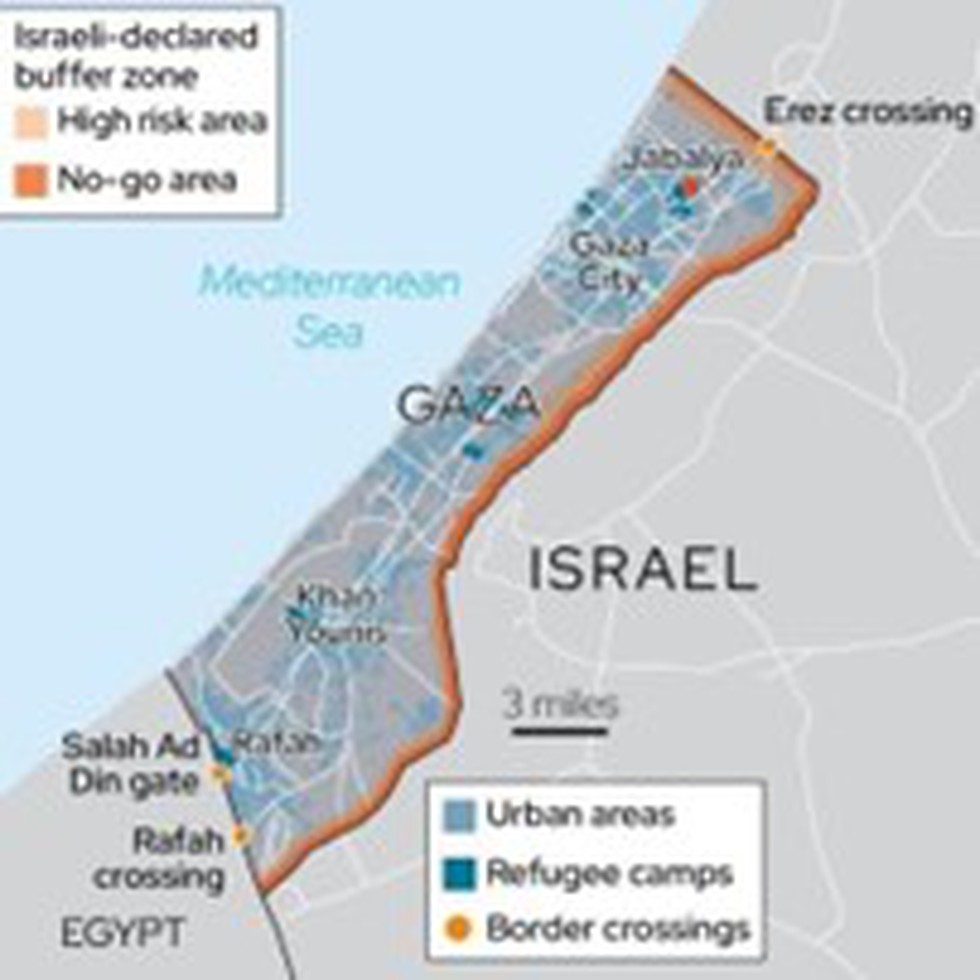
About Gaza Strip:
- The Gaza Strip is a self-governing Palestinian territory located on the eastern coast of the Mediterranean Sea.
- The territory takes its name from Gaza, its main city.
- It forms the smaller of the two Palestinian territories — the other being the West Bank.
- Bordering Countries: It is bordered by Israel to the north and east and Egypt to the south.
- Size: It is a 41km (25-mile) long and 10km-wide territory.
- Climate: It has a temperate climate, with mild winters, and dry, hot summer.
- Population:
- It is one of the most densely populated areas in the world. More than 2 million people live in the territory.
- The population is predominantly Palestinian, with the majority being Sunni Muslims.
- History:
- After Israel declared its statehood in 1948, Egypt controlled the Gaza Strip for nearly two decades
- Israel then gained control of the Gaza Strip and the West Bank after its victory in the 1967 Six-Day War against its Arab neighbours.
- For the next 38 years, Israel controlled the strip and enabled the construction of 21 Jewish settlements.
- In 2005, under international and domestic pressure, Israel withdrew around 9,000 Israeli settlers and its military forces from the Gaza Strip, leaving the enclave to be governed by the internationally recognised Palestinian Authority, which also controlled parts of the occupied West Bank.
- Who controls it now?
- Hamas, a Palestinian Islamist organisation, currently governs the Gaza Strip.
- It took control in 2007 after it won elections there the year before. Since then, no elections have been held.
- Hamas, unlike the Palestinian Authority, doesn't recognize Israel's right to exist.
- Israel has maintained a land, air and sea blockade on Gaza since 2007.

About White Goods:
- White goods are large home appliances such as stoves, refrigerators, freezers, washing machines, tumble driers, dishwashers, and air conditioners.
- They are large consumer durables for the house which were traditionally available only in white.
- Even though you can purchase them today in a wide range of different colors, they continue being called white goods.
- White goods are known for their durability and longevity, as they are designed to withstand the demands of daily use.
- The term may also refer to white fabrics, especially linen or cotton – articles such as curtains, towels, or sheets that historically used to be made of white cloth.
- In the beverage industry, white goods are colorless spirits, such as vodka or gin.
What are Brown Goods?
- They are relatively light electronic consumer durables such as computers, digital media players, TVs and radios.
- Unlike large household appliances (white goods), brown goods are more focused on entertainment, communication, and convenience.
- These devices often have electronic components, and their primary function is to provide audio, video, or data-related services.
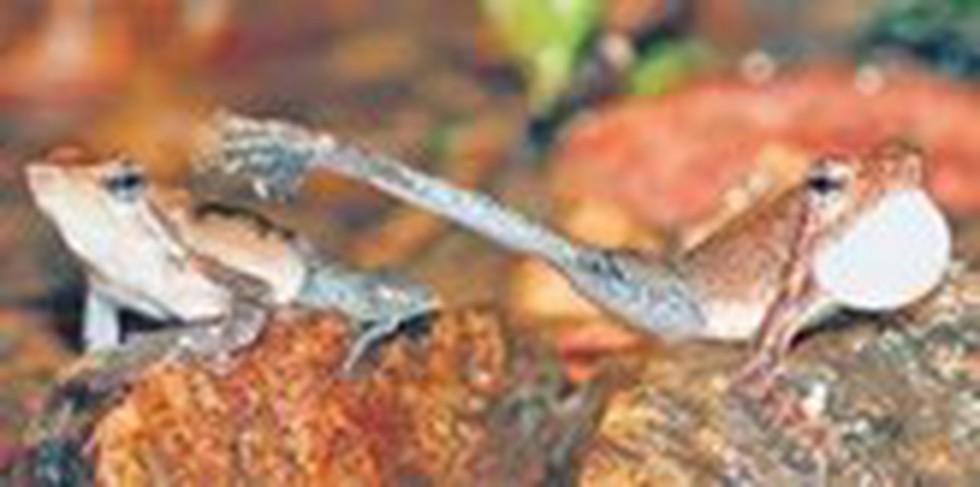
About Dancing frogs:
- These are endemic to the Western Ghats.
- Habitat: The species was found to prefer habitats in areas with thick canopy cover of at least 70-80 per cent
- It belongs to the Micrixalus genus.
- It is also the fifth most threatened genus in the world with 92 per cent of its species in the threatened category
- Behaviour
- The dancing frogs that are found near the streams do a unique display to mate.
- The males stretch up their hind legs one at a time and wave their webbed toes in the air in a rapid motion akin to a dance.
- This is to attract mates as well as ward off competition, probably preferred because their mating calls are drowned out by the gurgling of the streams.
- This act is called “foot flagging” and gives the species their name.
- Ecological significance:
- Frogs are valuable in the food chain and also provide other ecological services.
- Threats: These species are threatened by invasive species like the mosquito fish, land use change, variation in temperature and humidity, extreme weather events such as floods and excess rainfall, infectious diseases, water pollution, light pollution, and infrastructure projects.
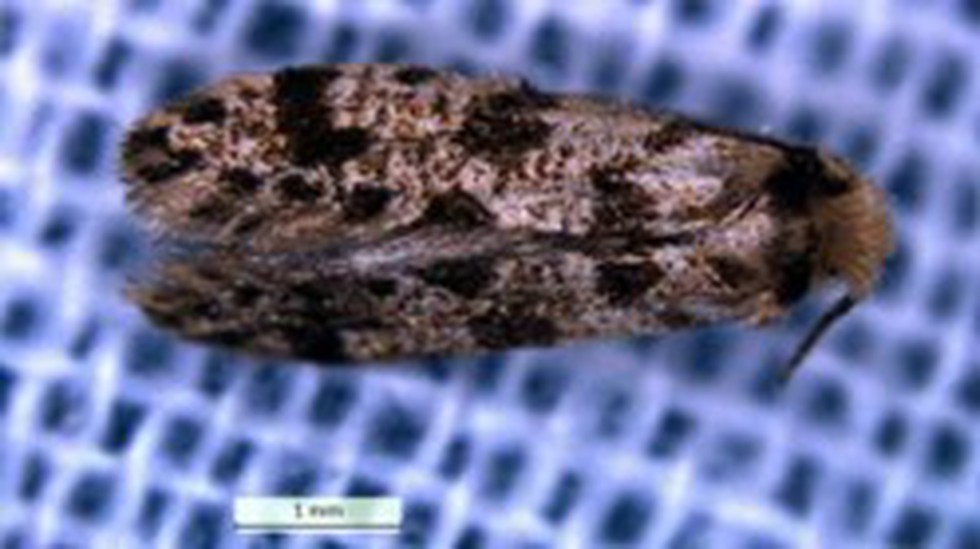
About Eumasia venefica:
- The new species has been named due to the peculiar shape of its bag, which resembles a wizard’s hat.
- It is the fourth species of this genus to be discovered from India.
- Features:
- It has the clever camouflage employed to escape predators.
- Larval cases of this species are found attached to rocks covered with lichens.
- The cases attach to each other and form a lichen covered colony.
- The larval bags look like a ‘witch’s hat’ because of a disc-like anterior and a tubular posterior part.
- It is not a polyphagous pest as its larvae only feed on the algae and mosses on the rocks.
What is Bagworm moth?
- They are a family of moths belonging to the order Lepidoptera and are known for their protective larval cases.
- These moths are found worldwide, but primarily in North America and Africa.
- It is a perennial moth like insect that resides on a number of evergreen as well as junipers in its larva stage.
- They are named for the baglike cases the larvae construct around themselves.
- The larvae are often destructive to trees, especially evergreens.

About Baiga Tribe:
- The Baiga Tribe is one of the Particularly Vulnerable Tribal Groups (PVTGs).
- They reside in Chhattisgarh, Jharkhand, Bihar, Odisha, West Bengal, Madhya Pradesh and Uttar Pradesh.
- Occupation: Traditionally, the Baiga lived a semi-nomadic life and practised slash-and-burn cultivation. Now, they are mainly dependent on minor forest produce for their livelihood.
- They practice a form of shifting cultivation called, "Bewar."
- Mahua is an important aspect of Baiga's food and drink. It is an intoxicant prepared from the fermentation and distillation of the flowers of the Mahua tree.
- Tattooing is an integral part of Baiga culture, every age and body part has a specific tattoo reserved for the occasion.
What are habitat rights?
- Habitat rights recognition provides the community concerned rights over their customary territory of habitation, socio-cultural practices, economic and livelihood means, intellectual knowledge of biodiversity and ecology, traditional knowledge of use of natural resources, as well as protection and conservation of their natural and cultural heritage.
- These rights safeguard and promote traditional livelihood and ecological knowledge passed down through generations.
- They also help converge different government schemes and initiatives from various departments to empower PVTG communities to develop their habitats.
- These rights are given under section 3(1) (e) [rights including community tenures of habitat and habitation for primitive tribal groups and pre-agricultural communities] of The Scheduled Tribes and Other Traditional Forest Dwellers (Recognition of Forest Rights) Act, 2006 also known as the Forest Rights Act (FRA).

About Indian Ocean Rim Association:
- It was established in 1997 as an intergovernmental organisation of States on the rim of the Indian Ocean.
- Member countries:
- It has members from Africa, West Asia, South Asia, Southeast Asia , Europe and Oceania.
- The Association’s membership has expanded to 23 member states and 11 dialogue partners.
- Asia: India, Bangladesh, Indonesia, Iran, Malaysia, Maldives, Oman, Singapore, Sri Lanka, Thailand, United Arab Emirates and Yemen.
- Africa: Kenya, Madagascar, Mozambique, Somalia , South Africa, Tanzania, Comoros, Mauritius, Seychelles.
- Oceania: Australia.
- Europe: France
- Its apex body is the Council of Foreign Ministers (COM) which meets annually.
- IORA has identified six priority areas namely: Trade and Investment, Maritime Safety and Security, Fisheries Management, Disaster Risk Management and Blue Economy.
- The secretariat is based in Ebène Mauritius and is overseen by a secretary-general who is appointed for a three-year period.





























































































































































.png)
.png)
.png)
.png)
.png)


.png)
.png)
.png)





.png)
.png)






.png)
.png)
.png)
.png)
.png)
.png)
.png)
.png)
.png)

.png)




.png)
.png)


.png)
.png)
.png)


.png)

.png)
.png)





.jpg)

.png)
.png)


.png)

.png)
.png)
.png)

.jpg)

.jpg)


.png)

.png)
.png)
.png)
.png)
.png)
.png)
.png)
.png)
.png)
.png)




.png)

.png)





.png)
.png)
.png)
.png)
.png)
.png)
.png)
.png)
.png)
.png)
.jpg)
.jpg)

.png)
.png)
.png)
.png)
.png)
.png)
.png)
.png)
.png)
.png)
.png)
.png)
.png)
.png)
.png)
.png)
.png)
.png)
.png)
.png)
.png)
.png)



.png)
.png)

.jpg)
.jpg)


.jpg)
.jpg)
.jpg)
.jpg)
.jpg)

.jpg)








.jpg)
.jpg)
.jpg)
.jpg)
.jpg)

















.jpg)
.jpg)







.jpg)


















.jpg)
.jpg)






























































































.jpg)
.jpg)


























.jpg)

.jpg)










.jpg)








.jpg)




.jpg)










.jpg)


















.jpg)












































.jpg)














.jpg)
.jpg)
.jpg)





.jpg)

.jpg)
.jpg)





































































.jpg)


































.jpg)
.jpg)
















































.jpg)












.jpg)


.jpg)




.jpg)
.jpg)
.jpg)

.jpg)
.jpg)
.jpg)
.jpg)

.jpg)
.jpg)
.jpg)

.jpg)
.jpg)
.jpg)
.jpg)
.jpg)
.jpg)
.jpg)
.jpg)

.jpg)


.jpg)
.jpg)
.jpg)
.jpg)
.jpg)
.jpg)
.jpg)
.jpg)
.jpg)
.jpg)











.jpg)
.jpg)





.jpg)
.jpg)
.jpg)
























.jpg)
























.jpg)









.jpg)
.jpg)







.jpg)
.jpg)









































.jpg)
.jpg)
.jpg)
.jpg)
.jpg)

.jpg)
.jpg)
.jpg)
.jpg)
.jpg)


.jpg)
.jpg)
.jpg)
.jpg)
.jpg)

.jpg)
.jpg)
.jpg)
.jpg)
.jpg)
.jpg)
.jpg)
.jpg)
.jpg)
.jpg)
.png)

.png)
.png)

.png)
.png)
.png)
.png)


.jpg)
.jpg)

.jpg)
.jpg)
.jpg)

.png)
.png)
.png)
.png)
.png)
.png)
.png)

.png)
.png)
.png)
.png)
.png)
.png)
.png)
.png)
.png)
.png)





































































-min.png)



.png)




.png)








































